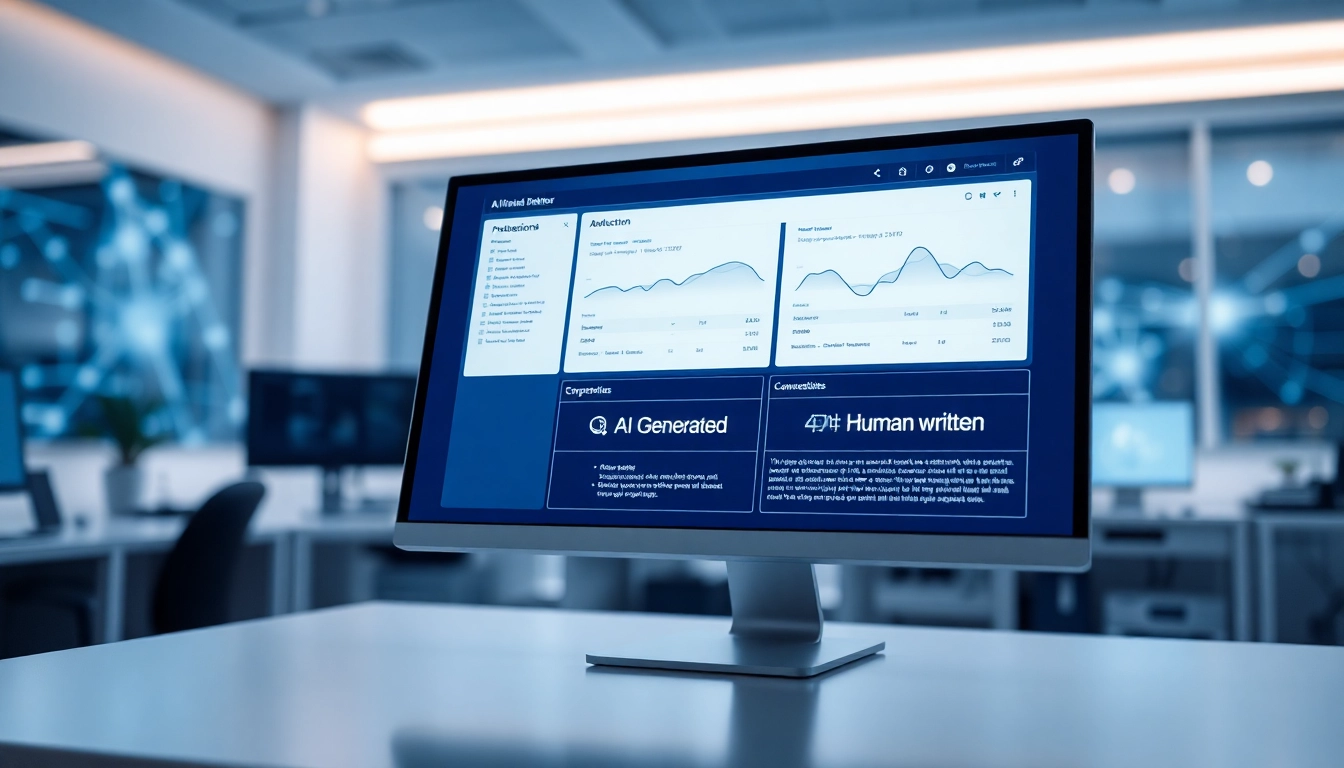
What is an AI Detector?
Definition and Overview of AI Detector
An ai detector is a tool designed to identify whether text has been generated by artificial intelligence or produced by a human. As AI technologies evolve and proliferate, especially natural language models like ChatGPT and others, the need for reliable detection methods becomes paramount. AI detectors leverage sophisticated algorithms to analyze text data, providing insights into the origins of the content and its authenticity. These tools are gaining traction in various sectors, including education, journalism, and marketing, where the integrity of content is crucial.
Components of an AI Detector
The primary components of an AI detector include:
- Text Analysis Algorithms: These algorithms examine the linguistic structure and patterns typical of AI-generated content.
- Machine Learning Models: Leveraging training datasets comprising both AI-generated and human-written texts helps models learn distinct characteristics.
- User Interface: A user-friendly interface enhances accessibility, allowing users to easily input text and receive results.
Applications of AI Detector in Different Industries
AI detectors find applications across a variety of fields:
- Education: Institutions can enforce academic integrity by detecting AI-generated essays and assignments.
- Publishing: Journalists utilize detectors to verify the source of articles and assess credibility.
- Marketing: Marketers can ensure authentic customer testimonials and feedback are not AI-generated, preserving trust.
How Do AI Detectors Work?
Algorithms and Techniques Behind AI Detector
AI detectors employ a range of algorithms, including statistical analysis and natural language processing (NLP). For instance, statistical models analyze word frequency, sentence length, and structure. NLP techniques, on the other hand, examine context, semantics, and syntactic variations to distinguish between human and machine writing. Frequent updates to models enhance accuracy, adapting to new AI developments.
Data Sources Utilized by AI Detector
To function effectively, AI detectors utilize vast datasets, including:
- Training Data: Collections of both AI-generated and human-written texts help establish baselines.
- Publicly Available Texts: Books, articles, and online content form part of the training set for pattern recognition.
Combining these data sources aids in optimizing prediction algorithms, ultimately improving detection efficacy.
Accuracy and Reliability of AI Detector
The reliability of AI detectors is continually assessed through rigorous testing against benchmark datasets. Accuracy metrics typically focus on the rate of true positives (correctly identified AI text) and false positives (human text incorrectly flagged as AI). Advanced models may incorporate ensemble learning, combining results from multiple algorithms to enhance accuracy.
Benefits of Using AI Detectors
Enhancing Content Quality with AI Detector
One of the most significant benefits of implementing an AI detector is the enhancement of content quality. By identifying AI-generated text, organizations can ensure that the content they publish adheres to authenticity standards. This fosters a culture of transparency, encouraging the generation of original thought and improving overall content quality.
Preventing Misinformation Using AI Detector
In today’s digital landscape, misinformation spreads rapidly. AI detectors play a vital role in curbing this phenomenon by verifying the sources of content. By employing these tools, organizations can flag AI-generated information that may mislead audiences, effectively contributing to the fight against misinformation on digital platforms.
Boosting Academic Integrity with AI Detector
Academic institutions can harness AI detectors to maintain the integrity of their educational systems. Detecting AI-generated assignments allows educators to ensure that students engage in genuine learning processes, rather than relying on AI tools to complete their work. Such diligence preserves academic standards and accountability.
Challenges in AI Detection
Limitations of Current AI Detector Technologies
Despite significant advancements, AI detectors face limitations. Variability in writing styles and nuanced human language pose challenges in developing foolproof detection methods. Additionally, some sophisticated AI models generate text that closely mimics human writing, increasing the risk of misclassification, resulting in potentially false negatives and positives.
Addressing False Positives in AI Detector Results
False positives represent a common pain point when using AI detectors. These occur when human-written text is incorrectly identified as AI-generated. To mitigate this issue, continuous training datasets must include diverse human writing examples, reflecting the broad range of human expression and language use. Regular updates to detection algorithms based on user feedback also enhance model reliability.
Future Improvements for AI Detector
The future of AI detectors involves leveraging advanced machine learning techniques such as deep learning and reinforcement learning. These technologies promise improved detection capabilities by enabling models to learn contextually and recognize subtleties in human writing better. Moreover, ongoing feedback loops can enhance model performance by integrating real-world user data.
Implementing an AI Detector in Your Workflow
Steps to Incorporate AI Detector in Content Creation
Integrating an AI detector into your content creation process involves several steps:
- Identify Requirements: Determine the need for AI detection based on specific content types.
- Select an AI Detector: Choose a detector that aligns with your requirements, considering aspects such as accuracy and ease of use.
- Integrate with Existing Systems: Ensure the AI detector can seamlessly integrate into your workflow or content management system.
- Train Users: Educate your team on the tool’s functionalities and best practices for effective utilization.
Best Practices for Using AI Detector Effectively
To maximize the efficacy of an AI detector, consider the following best practices:
- Regularly update detection algorithms to align with the latest AI developments.
- Provide user feedback for continuous improvement of detector performance.
- Utilize the detector not only for detection but for insights into writing style and quality enhancement.
Evaluating Performance Metrics of AI Detector
Assessing the performance of an AI detector involves analyzing key metrics such as:
- Accuracy: The ratio of correctly identified AI-generated text to total text analyzed.
- False Positive Rate: The frequency at which human-written text is wrongly classified as AI-generated.
- User Satisfaction: Feedback from users can illuminate areas of improvement.
Ideally, a comprehensive evaluation strategy should consider both quantitative metrics and qualitative user insights for thorough analysis.